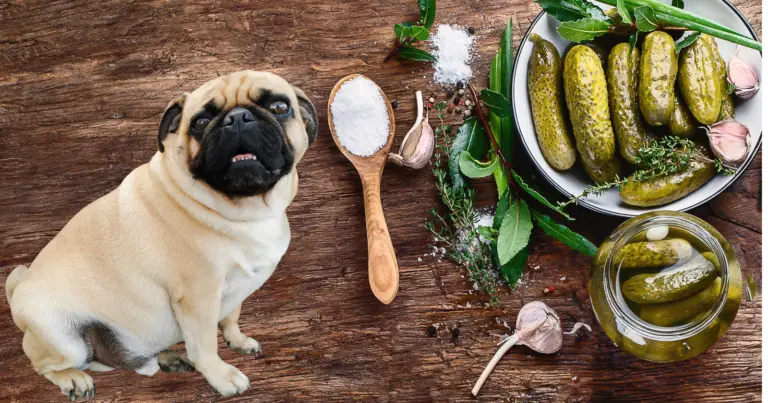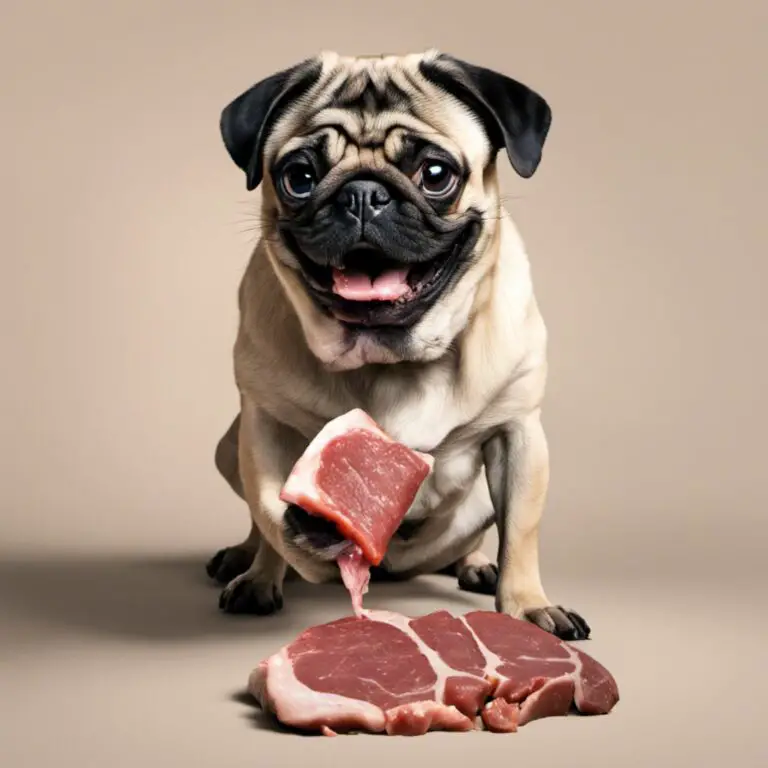Can Pugs Eat Peas? A Concise Guide for Pet Owners

As a pug owner, you might wonder if it’s safe for your furry friend to snack on peas. Dogs’ diets can sometimes be a minefield to navigate, especially regarding certain human foods. You want the best for your pug, so it’s important to know what foods are safe and beneficial for them to consume. So without further ado, let’s discover “Can Pugs Eat Peas.”

Peas are not only safe for pugs but can also be a healthy addition to their diet when given in moderation. Packed with antioxidants, vitamins, and fiber, peas can provide some essential nutrients for your pug’s overall well-being. Whether fresh, frozen, or unsalted, it’s a good idea to introduce peas gently to see how your pug reacts before making them a regular part of their meals.
With a wide variety of pet-friendly fruits and vegetables available, it’s crucial to stay informed about the types of foods that are safe for your pug. Adding peas to your pug’s diet, given in the right quantities and frequencies, can be a great way to diversify their nutrient intake and keep them happy and healthy.
Contents
Table of Contents
Understanding Pugs as Omnivores

As a pug owner, it’s important to understand that pugs are omnivores, meaning they can eat various foods, including meat, vegetables, and fruits. Just like humans, pugs benefit from a balanced diet that includes proteins, carbohydrates, fats, and other essential nutrients.
Get The Free Food Eating Guide That Keeps My Pug Happy and Playful Even at 13 Years Old
100% Beginner Friendly & Lists Real Foods Your Pug Can Actually Eat!
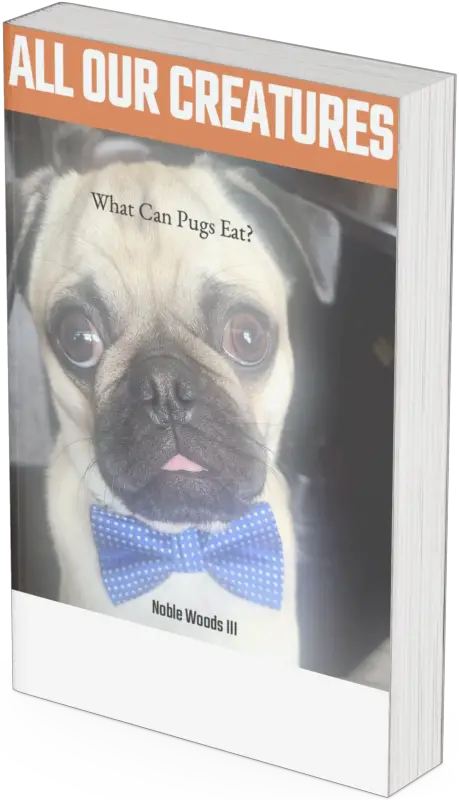
When planning your pug’s diet, remember that protein should be a primary component of their meals. Sources of protein can come from both meat and vegetable options. You support their overall health and growth by providing your pug with a diverse range of protein sources. In addition to meat, don’t forget to include vegetables and fruits as these provide essential vitamins, minerals, and antioxidants.
As you introduce new foods into your pug’s diet, observe how they react to these additions. It’s important to be selective with the types of vegetables and fruits you feed your pug, as not all options are safe for them to consume. For example, it’s important to know that pugs can indeed eat peas, which provide beneficial vitamins and minerals. However, always be mindful of portion sizes and opt for fresh, frozen, or unsalted varieties when incorporating peas into your pug’s meals.
Remember that while pugs can eat a variety of human foods, some options should be avoided as they can be toxic to dogs. For instance, items such as grapes, avocados, and onions should not be included in a pug’s diet.
To maintain a well-rounded diet for your pug, remember to not solely rely on any one vegetable, fruit, or meat option. Instead, providing a diverse range of safe and appropriate foods will ensure they get all the necessary nutrients. In doing so, you’re ensuring your pug remains healthy and happy throughout its life.
Peas in a Pug’s Diet

Peas can be a great addition to your pug’s diet. They are safe for dogs and can provide a variety of essential nutrients your furry friend needs. Remember to do so in moderation when introducing peas to your pug’s meals.
One of the numerous benefits of peas is that they are rich in vitamins and minerals. They contain essential nutrients such as vitamins A, and C, fiber, and antioxidants, supporting your pug’s overall health. The fiber content in peas can aid digestion and promote regular bowel movements.
Opt for fresh, frozen, or unsalted varieties when serving peas to your pug. Avoid giving peas that have been prepared with butter, salt, or spices, as these can harm your pet’s digestive system. The safest way to serve peas to your pug is by lightly steaming or boiling them without any additives. This will preserve the natural nutrients.
Remember that while peas offer valuable nutrients, they should not be the primary component of your pug’s diet. The essential elements of a balanced diet for your pug should include a mix of proteins, carbohydrates, and fats from multiple sources.
Additionally, monitoring your pug’s consumption of legumes, including peas, is crucial. The FDA has alerted pet owners about potential links between canine dilated cardiomyopathy (DCM) in dogs and the consumption of dog food brands containing peas. So, ensure you’re feeding peas to your pug in a safe and moderate manner.
In summary, incorporating peas into your pug’s diet can be beneficial as long as it’s done with care and moderation. Peas can provide various essential nutrients, such as vitamins, minerals, and antioxidants, but it’s vital to serve them appropriately and be mindful of potential risks.
Benefits of Peas for Pugs

Peas can be an excellent addition to your Pug’s diet. These small, green legumes offer multiple health benefits for your furry friend.
Firstly, peas are a great source of fiber, which aids in digestion and can help maintain a healthy weight. A diet rich in fiber may contribute to the overall well-being of your Pug. Additionally, peas contain essential vitamins and minerals such as iron, which can support your dog’s immune system and overall health1.
Moreover, peas are packed with antioxidants to help reduce inflammation and keep your dog healthy as they age 2. These antioxidants work together to protect your Pug from potential health issues such as heart disease3 and coat deterioration due to aging.
Peas support your Pug’s internal health and can also play a role in maintaining a healthy and shiny coat. The lutein found in peas is an antioxidant that promotes skin and eye health, making it an ideal addition to your Pug’s diet to keep their appearance in top condition4.
Incorporating peas into your Pug’s meals can undoubtedly provide numerous health benefits. Just remember to moderate the size of the portions to avoid overfeeding. By nourishing your Pug with this nutrient-rich food, you can work towards maintaining their overall health and well-being.
Risks and Precautions

Feeding your pug peas can be a healthy option when done in moderation. However, there are some risks and precautions to consider when incorporating peas into their diet.
Overfeeding your pug peas may lead to digestive issues like vomiting and diarrhea. To avoid this, remember to follow the 10% rule that treats, including vegetables like peas, should only make up 10% of your dog’s overall calories.
When feeding peas to your pug, choosing fresh or frozen varieties is essential, as these have lower salt and sodium content. Canned peas often contain high sodium levels and additives, making them less ideal for your pug’s health. Additionally, peas can be served cooked or raw, but make sure to remove any hard shells if using sugar snap or English peas.
Although peas are not toxic or harmful, they still contain natural sugars, which can contribute to obesity if excessively consumed. Maintaining a balanced diet for your pug is essential to ensure their overall health and avoid weight gain.
As with any dietary changes, monitoring your pug’s reaction to peas is crucial. Watch for signs of discomfort or adverse reactions, such as vomiting, diarrhea, or lethargy. If you notice any of these symptoms, contact your veterinarian for advice and guidance on the best course of action.
In summary, while peas can be a safe and healthy treat for your pug, feeding them in moderation is essential, choosing the right varieties, and closely monitoring your pug’s reaction. By taking these precautions, you can ensure that your pug enjoys a balanced and nutritious diet.
Preparation Methods for Peas
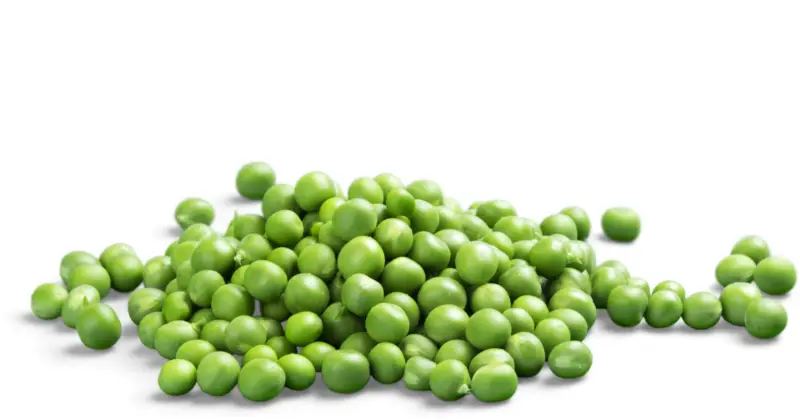
When feeding peas to your pug, it’s essential to prepare them in a safe and healthy way. Below are various preparation methods for peas to consider when sharing this nutritious treat with your pug.
First, always ensure that you use fresh, frozen, or plain canned peas in your pug’s diet. These types of peas are typically free of harmful additives and retain most of their natural nutrients. Remember that it’s best to avoid peas that have added salt or other seasonings, as these can harm your dog.
To prepare fresh peas, you must remove them from their pods and wash them thoroughly. Once rinsed, you have several options for cooking the peas. One common method is to steam the peas, which helps retain their nutrients while making them easier for your pug to digest. Place the peas in a steamer basket over a pot of boiling water, and steam them for about 3-5 minutes until they are tender but still bright green.
Boiling the peas is another option for softening them and making them more appealing to your pug. Simply add the fresh or frozen peas to a pot of boiling water, and cook for a few minutes until they are tender. Be careful not to overcook them, as this can cause them to lose some of their nutritional value. Once cooked, strain the peas and allow them to cool down before offering them to your dog.
If using frozen peas, you can also opt to thaw them without any additional cooking, as they are typically pre-cooked before freezing. Just place the frozen peas in a bowl and let them sit at room temperature until they are softened, then serve them to your pug as a tasty and cool treat.
For plain canned peas, draining and rinsing them is recommended to remove any excess sodium or liquid that may be present. After draining, you can choose to serve them as-is or slightly warm them up.
No matter which method you choose, remember to serve the peas in moderation, as they should only make up a small portion of your pug’s diet. By incorporating peas safely and healthily, you’re providing your pug with a delicious and nutritious treat they’re sure to love.
Can Pugs Eat Peas? Watch this
Serving Peas to Pugs
When feeding peas to your Pug, it’s essential to offer them in moderation. Peas can be a nutritious addition to your dog’s diet, providing vitamins, antioxidants, and fiber, as described on the Black Pug Site. However, they should not replace their regular dog food or become a primary source of nutrition.
Incorporate peas as an occasional treat rather than a staple part of your Pug’s diet. When introducing this legume, it’s crucial to start with a small amount and observe how your dog reacts. Some dogs might love peas, while others may display signs of gastrointestinal discomfort. Make sure to monitor your Pug’s reaction and adjust the serving size accordingly.
Choose fresh, frozen, or unsalted varieties to serve peas to your Pug. Avoid canned peas, as they often contain additives and high sodium levels, which can be harmful to dogs. You can serve peas as a standalone treat or mix them with other dog-friendly vegetables or dog treats. Always ensure the peas are plain, without any added seasoning or spices, as these can cause adverse reactions in your pet.
You can also consider offering different types of peas for variety, such as sugar snap peas, snow peas, or English peas, as mentioned on the Black Pug Site. Including peas in your Pug’s diet can be a healthy and enjoyable snack, provided they are served responsibly and in moderation. Remember always to prioritize your dog’s overall well-being and consult your veterinarian for personalized advice on your Pug’s nutritional needs.
Alternatives to Peas in a Pug’s Diet
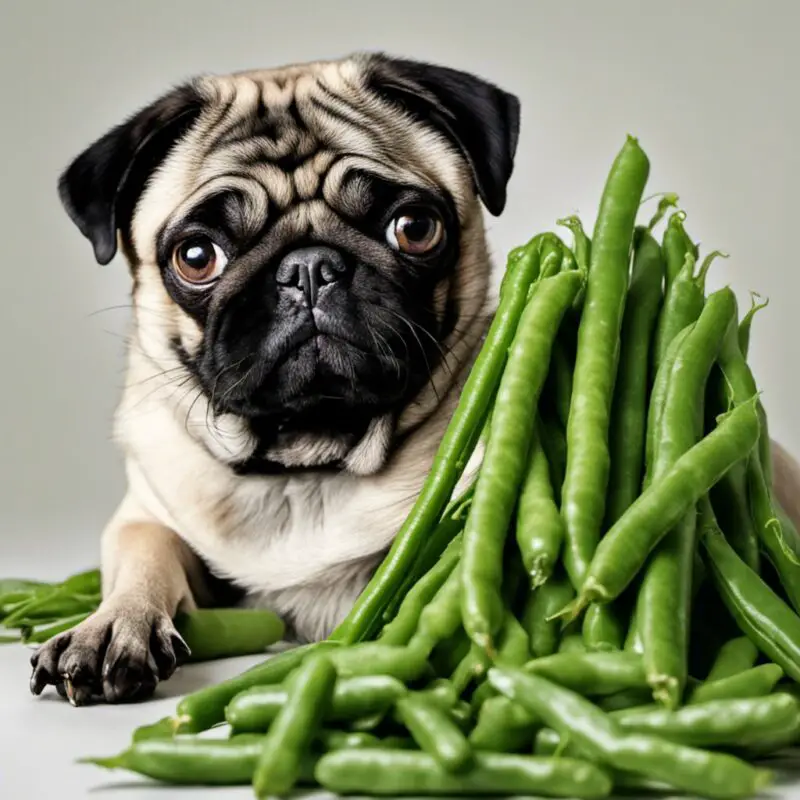
If you want to diversify your pug’s diet or add other healthy snacks, there are plenty of options besides peas. One nutritious option is carrots, which are rich in vitamins and antioxidants. These crunchy treats also promote good dental health by removing plaque from your pug’s teeth.
Green beans are another fantastic alternative that can provide essential nutrients to your pug. They are low in calories and high in vitamin C, vitamin K, and manganese. They can be cooked or served raw, but make sure to remove any tough strings before offering them to your pug.
Adding broccoli to your pug’s diet can also support their overall health. This nutrient-dense vegetable is loaded with vitamins A, C, K, and B9, potassium, and fiber. Be sure to serve it in small amounts and cooked to avoid choking hazards and potential digestive upsets.
Celery can be a refreshing and beneficial snack for your pug, containing essential vitamins and minerals. Chopping it into small pieces makes it more manageable, but always monitor your pug while they eat to prevent choking.
For a more energy-filled treat, consider sweet potatoes. They are an excellent source of beta-carotene, fiber, and several vitamins. Serve in moderation, as too much can lead to weight gain.
Introducing fruits into your pug’s diet is another way to incorporate different flavors and textures. Fruits like bananas, mangoes, oranges, and peaches contain vitamins, antioxidants, and natural sugars. Just remember to remove any seeds or pits from these fruits to ensure your pug’s safety, and serve them in moderation to avoid weight gain.
In conclusion, various fruits and vegetables can be a healthy addition to your pug’s diet besides peas. Explore these options, find what works best for your pug, and consult your veterinarian if you have any concerns or questions.
Foods to Avoid in a Pug’s Diet
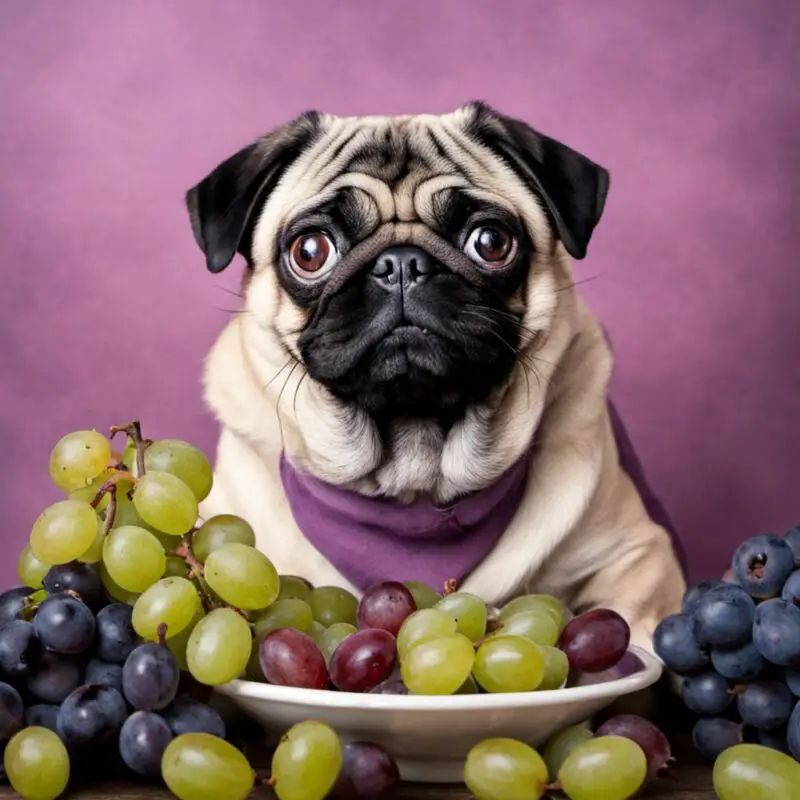
When preparing a meal or considering treats for your pug, it’s essential to understand which foods can harm their health. Some common foods to avoid in your pug’s diet include onions, garlic, avocado, and grapes. These foods contain toxins that can cause adverse reactions in your pug.
Firstly, you should avoid giving your pug onions and garlic. These vegetables contain compounds called N-propyl disulfide and thiosulfate, which can cause damage to your pug’s red blood cells, leading to a condition called hemolytic anemia. The effects can range from weakness and lethargy to more severe signs such as vomiting and difficulty breathing.
Avocados are another food to be cautious with when feeding your pug. They contain a toxin called persin, which can cause gastrointestinal issues. Although small amounts of avocado may be harmless, it’s best to avoid giving it to your pug to prevent any potential health problems.
Grapes and their dried counterparts, raisins, are also dangerous for your pug. Although the specific toxin responsible is still unidentified, ingesting grapes can lead to acute kidney failure in dogs. Symptoms include vomiting, diarrhea, and a decrease in appetite.
Aside from these specific foods, there are other general items to avoid in a pug’s diet. High-fat foods can lead to obesity and gastrointestinal problems. Additionally, caffeine products can cause fatigue, disorientation, and seizures. To maintain your pug’s health, paying attention to the ingredients in their meals and opt for safer options is essential. Always consult your veterinarian if you are unsure about any food items or have concerns about your pug’s diet.
Frequently Asked Questions: Can Pugs Eat Peas?
Can dogs have canned or frozen peas?
Yes, dogs can consume both canned and frozen peas. However, it’s essential to ensure that canned peas are free from added salt, sugar, or other preservatives, as these can be harmful to your dog. Frozen peas are a healthier option, as they usually do not contain any additives. Always ensure that the peas are thoroughly defrosted before feeding them to your dog.
Are peas harmful to a dog’s heart?
Peas, when fed in moderation, are not harmful to a dog’s heart. In fact, peas are rich in vitamins, minerals, fiber, and protein, which can benefit your dog’s overall health source. However, it’s essential to follow a balanced diet for your dog and not overfeed them with peas, as overconsumption of any food could lead to health issues.
Can dogs consume peas with carrots?
Yes, dogs can eat peas and carrots together. Both vegetables are safe and nutritious for dogs when served in moderation. Carrots are low in calories, high in fiber, and a good source of vitamins and minerals that can contribute to your dog’s overall health.
Are sweet peas safe for dogs?
Sweet peas, specifically the Pod and seeds, should not be confused with the common garden peas. Sweet peas are not safe for dogs to consume, as they contain toxic compounds that can cause vomiting, diarrhea, and other health issues.
Is it okay for dogs to eat green beans?
Yes, it is safe for dogs to eat green beans. They are a healthy, low-calorie source of vitamins, minerals, and fiber that can be incorporated into your dog’s diet. However, always ensure to serve them plain, without added salt, seasonings, or oils, which can harm your dog’s health.
Can dogs eat raw snow peas?
Dogs can eat raw snow peas; they are safe and contain essential nutrients. However, make sure to remove the stringy parts on the sides of the pea pod, as these can be difficult for your dog to digest. As with any other food, it is essential to serve snow peas in moderation, ensuring your dog maintains a balanced diet.

